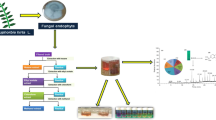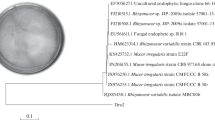Abstract
This study profiled the various endophytic fungi isolated from the orchid Cymbidium sp. and their L-asparaginase production and antioxidant potential. The L-asparaginase production was first screened through qualitative plate screening then quantified by the Nesslerization method. The antioxidant potential was quantified via the 2,2-diphenyl-1-picrylhydrazyl assay. A total of 30 endophytic fungi were isolated and all fungal isolates exhibited various degrees of radical scavenging activities (45.28% to 76.4%). Isolate Lasiodiplodia theobromae (C11) had the highest antioxidant capacity, represented by the lowest IC50 value (5.75 mg/mL) and highest ascorbic acid equivalent antioxidant capacity value (12.17 mg/g). Additionally, 16 isolates produced L-asparaginase (53.33%), which includes primarily species of Fusarium proliferatum, Fusarium fujikuroi, Fusarium incarnatum, and Fusarium oxysporum. A new isolate has also been discovered from Cymbidium orchid, Buergenerula spartinae (C28), which showed the highest L-asparaginase activity (1.736 unit/mL). These findings supported the postulation that medicinal species of Orchidaceae such as Cymbidium sp. harbor endophytes that are producers of L-asparaginase and antioxidants with various potential applications.




Similar content being viewed by others
Data availability
The data that support the findings of this study are available from the corresponding author, upon request.
References
Ali DI, Ouf SA, Eweis M, Soliman DM (2018) Optimization of L-asparaginase production from some filamentous fungi with potential pharmaceutical properties. Egypt J Bot 58:355–369. https://doi.org/10.21608/ejbo.2018.2945.1152
Amer MN, Atwa NA, Eldiwany AI, Elgammal EW, Dawoud IE, Rashad FM (2022) Anticancer and antioxidant activities of L-asparaginase produced by local Weissella paramesenteroides MN2C2 strain. Egypt J Chem 65:409–419. https://doi.org/10.21608/ejchem.2021.102465.4832
Axiotis E, Angelis A, Antoniadi L, Petrakis EA, Skaltsounis LA (2022) Phytochemical analysis and dermo-cosmetic evaluation of Cymbidium sp. (Orchidaceae) cultivation by-products. Antioxidants 11:101. https://doi.org/10.3390/antiox11010101
Balbool BA, Abdel-Azeem AM (2020) Diversity of the culturable endophytic fungi producing L-asparaginase in arid Sinai, Egypt. Italian J Mycol 49:8–24. https://doi.org/10.6092/issn.2531-7342/10063
Bhavana NS, Prakash HS, Nalini MS (2019) Antioxidative and L-asparaginase potentials of fungal endophytes from Rauvolfia densiflora (Apocynaceae), an ethnomedicinal species of the Western Ghats. Czech Mycol 71:187–203. https://doi.org/10.33585/cmy.71205
Bungtongdee N, Sopalun K, Laosripaiboon W, Iamtham S (2019) The chemical composition, antifungal, antioxidant and antimutagenicity properties of bioactive compounds from fungal endophytes associated with Thai orchids. J Phytopathol 167:56–64. https://doi.org/10.1111/jph.12773
Caicedo NH, Davalos AF, Puente PA, Rodriguez AY, Caicedo PA (2019) Antioxidant activity of exo-metabolites produced by Fusarium oxysporum: an endophytic fungus isolated from leaves of Otoba gracilipes. Microbiology Open 8:e903. https://doi.org/10.1002/mbo3.903
Chow YY, Ting ASY (2015) Endophytic L-asparaginase-producing fungi from plants associated with anticancer properties. J Adv Res 6:869–876. https://doi.org/10.1016/j.jare.2014.07.005
Chua RW, Song KP, Ting ASY (2022) Antimicrobial activities and phytochemical screening of endophytic fungi isolated from Cymbidium and Dendrobium orchids. S Afr J Bot 151:909–918. https://doi.org/10.1016/j.sajb.2022.11.015
Cui JL, Guo TT, Ren ZX, Zhang NS, Wang ML (2015) Diversity and antioxidant activity of culturable endophytic fungi from alpine plants of Rhodiola crenulata, R. angusta, and R. sachalinensis. Plos One 10:e0118204. https://doi.org/10.1371/journal.pone.0118204
Das M, Prakash HS, Nalini MS (2017) Antioxidative properties of phenolic compounds isolated from the fungal endophytes of Zingiber nimmonii (J. Graham) Dalzell. Front Biol 12:151–162. https://doi.org/10.1007/s11515-016-1441-z
de Pádua APSL, de Sousa Freire KTL, de Oliveira TGL, da Silva LF, Araújo-Magalhães GR, Agamez-Montalvo GS, da Silva IR, Bezerra JDP, de Souza-Motta CM (2018) Fungal endophyte diversity in the leaves of the medicinal plant Myracrodruon urundeuva in a Brazilian dry tropical forest and their capacity to produce L-asparaginase. Acta Bot Bras 33:1–11. https://doi.org/10.1590/0102-33062018abb0108
Duan X, Xu F, Qin D, Gao T, Shen W, Zuo S, Yu B, Xu J, Peng Y, Dong J (2019) Diversity and bioactivities of fungal endophytes from Distylium chinense, a rare waterlogging tolerant plant endemic to the Three Gorges Reservoir. BMC Microbiol 19:278. https://doi.org/10.1186/s12866-019-1634-0
Elfita, Oktiansyah R, Mardiyanto, Widjajanti H, Setiawan A, Nasution SSA (2023) Bioactive compounds of endophytic fungi Lasiodiplodia theobromae isolated from the leaves of Sungkai (Peronema canescens). Biointerface Res Appl Chem 13:530. https://doi.org/10.33263/BRIAC136.530
Fouda AH, Hassan SED, Eid AM, Ewais EED (2015) Biotechnological applications of fungal endophytes associated with medicinal plant Asclepias sinaica (Bioss.). Ann Agric Sci 60:95–104. https://doi.org/10.1016/j.aoas.2015.04.001
Gautam VS, Singh A, Kumari P, Nishad JH, Kumar J, Yadav M, Bharti R, Prajapati P, Kharwar RN (2022) Phenolic and flavonoid contents and antioxidant activity of an endophytic fungus Nigrospora sphaerica (EHL2), inhabiting the medicinal plant Euphorbia hirta (dudhi) L. Arch Microbiol 204:140. https://doi.org/10.1007/2Fs00203-021-02650-7
Gulati R, Saxena RK, Gupta R (1997) A rapid plate assay for screening L-asparaginase producing micro-organisms. Lett Appl Microbiol 24:23–26. https://doi.org/10.1046/j.1472-765x.1997.00331.x
Gunasekaran S, Sathiavelu M, Arunachalam S (2017) In vitro antioxidant and antibacterial activity of endophytic fungi isolated from Mussaenda luteola. J Appl Pharm Sci 7:234–238. https://doi.org/10.7324/JAPS.2017.70832
Gupta S, Chaturvedi P, Kulkarni MG, Staden JV (2020) A critical review on exploiting the pharmaceutical potential of plant endophytic fungi. Biotechnol Adv 39:107462. https://doi.org/10.1016/j.biotechadv.2019.107462
Gutiérrez RMP (2010) Orchids: a review of uses in traditional medicine, its phytochemistry and pharmacology. J Med Plants Res 4:592–638. https://doi.org/10.5897/JMPR10.012
Hatamzadeh S, Rahnama K, Nasrollahnejad S, Fotouhifar KB, Hemmati K, White JF, Taliei F (2020) Isolation and identification of L-asparaginase-producing endophytic fungi from the Asteraceae family plant species of Iran. PeerJ 8:e8309. https://doi.org/10.7717/peerj.8309
Holker U, Hofer M, Lenz J (2004) Biotechnological advantages of laboratory-scale solid-state fermentation with fungi. Appl Microbiol Biotechnol 64:175–186. https://doi.org/10.1007/s00253-003-1504-3
Hosamani R, Kaliwal BB (2011) Isolation, molecular identification and optimization of fermentation parameters for the production of L-asparaginase, an anticancer agent by Fusarium equisetii. Int J Microbiol Res 3:108–119. https://doi.org/10.9735/0975-5276.3.2.108-119
Ibrahim M, Oyebanji E, Fowora M, Aiyeolemi A, Orabuchi C, Akinnawo B, Adekunle AA (2021) Extracts of endophytic fungi from leaves of selected Nigerian ethnomedicinal plants exhibited antioxidant activity. BMC Complement Med Ther 21:98. https://doi.org/10.1186/s12906-021-03269-3
Jia M, Chen L, Xin HL, Zheng CJ, Rahman K, Han T, Qin LP (2016) A friendly relationship between endophytic fungi and medicinal plants: a systematic review. Front Microbiol 7:906. https://doi.org/10.3389/2Ffmicb.2016.00906
Kai G, Wu C, Gen L, Zhang L, Cui L, Ni X (2015) Biosynthesis and biotechnological production of anti-cancer drug Camptothecin. Phytochem Rev 14:525–539. https://doi.org/10.1007/s11101-015-9405-5
Khan F, Ahmad A, Khan MI (2007) Purification and characterization of a lectin from endophytic fungus Fusarium solani having complex sugar specificity. Arch Biochem Biophys 457:243–251. https://doi.org/10.1016/j.abb.2006.10.019
Khan N, Afroz F, Begum MN, Rony SR, Sharmin S, Moni F, Hasan CM, Shaha K, Sohrab MH (2018) Endophytic Fusarium solani: a rich source of cytotoxic and antimicrobial napthaquinone and aza-anthraquinone derivatives. Toxicol Rep 5:970–976. https://doi.org/10.1016/2Fj.toxrep.2018.08.016
Kumar A, Patil D, Rajamohanan PR, Ahmad A (2013) Isolation, purification and characterization of vinblastine and vincristine from endophytic fungus Fusarium oxysporum isolated from Catharanthus roseus. PLoS ONE 8:e71805. https://doi.org/10.1371/journal.pone.0071805
Lai HY, Lim YY (2011) Evaluation of antioxidant activities of the methanolic extracts of selected ferns in Malaysia. Int J Environ Sci Dev 2:442–447. https://doi.org/10.7763/IJESD.2011.V2.166
Li L, Liu C, Wen W, Li Q, Pan T, Li Z, Qian G, He Y, Xu D (2022) Dendrobine biosynthesis in Dendrobium nobile in four different habitats is affected by the variations in the endophytic fungal community. Front Microbiol 13:981070. https://doi.org/10.3389/fmicb.2022.981070
Lobo V, Patil A, Phatak A, Chandra N (2010) Free radicals, antioxidants and functional foods: Impact on human health. Pharmacogn Rev 4:118–126. https://doi.org/10.4103/2F0973-7847.70902
Lv SS, Fu Y, Chen J, Jiao Y, Chen SQ (2022) Six phenanthrenes from the roots of Cymbidium faberi Rolfe. and their biological activities. Nat Prod Res 36:1170–1181. https://doi.org/10.1080/14786419.2020.1862836
Manasa C, Nalini MS (2014) L-asparaginase activity of fungal endophytes from Tabernaemontana heyneana Wall. (Apocynaceae), endemic to the Western Ghats (India). Int Sch Res Notices 2014:1–7. https://doi.org/10.1155/2014/925131
Mengistu AA (2020) Endophytes: Colonization, behaviour, and their role in defense mechanism. Int J Microbiol 2020:6927219. https://doi.org/10.1155/2020/6927219
Moubasher HA, Balbool BA, Helmy YA, Alsuhaibani AM, Atta AA, Sheir DH, Abdel-Azeem AM (2022) Insights into asparaginase from endophytic fungus Lasiodiplodia theobromae: Purification, characterization and antileukemic activity. Int J Environ Res Public Health 19:680. https://doi.org/10.3390/ijerph19020680
Nakahama K, Imada A, Igarasi S, Tubaki K (1973) Formation of L-asparaginase by Fusarium species. J Gen Microbiol 75:269–273. https://doi.org/10.1099/00221287-75-2-269
Nisa S, Khan N, Shah W, Sabir M, Khan W, Bibi Y, Jahangir M, Haq IU, Alam S, Qayyum A (2020) Identification and bioactivities of two endophytic fungi Fusarium fujikuroi and Aspergillus tubingensis from foliar parts of Debregeasia salicifolia. Arab J Sci Eng 45:4477–4487. https://doi.org/10.1007/s13369-020-04454-1
Nongkhlaw FMW, Joshi SR (2015) L-Asparaginase and antioxidant activity of endophytic bacteria associated with ethonomedicinal plants. Indian J Biotechnol 14:59–64
Pan F, Su TJ, Cai SM, Wu W (2017) Fungal endophyte-derived Fritillaria unibracteata var. wabuensis: diversity, antioxidant capacities in vitro and relations to phenolic, flavonoid or saponin compounds. Sci Rep 7:42008. https://doi.org/10.1038/srep42008
Pant B (2013) Medicinal orchids and their uses: tissue culture a potential alternative for conservation. Afr J Plant Sci 7:448–467. https://doi.org/10.5897/AJPS2013.1031
Ramya M, Park PH, Chuang YC, Kwon OK, An HR, Park PM, Baek YS, Kang BC, Tsai WC, Chen HH (2019) RNA sequencing analysis of Cymbidium goeringii identifies floral scent biosynthesis related genes. BMC Plant Biol 19:337. https://doi.org/10.1186/2Fs12870-019-1940-6
Salvatore MM, Alves A, Andolfi A (2020) Secondary metabolites of Lasiodiplodia theobromae: distribution, chemical diversity, bioactivity, and implications of their occurrence. Toxins 12:457. https://doi.org/10.3390/toxins12070457
Sarquis MIM, Oliveira EMM, Santos AS, da Costa GL (2004) Production of L-asparaginase by filamentous fungi. Mem Inst Oswaldo Cruz 99:489–492. https://doi.org/10.1590/s0074-02762004000500005
Savitri AN, Azmi W (2003) Microbial L-asparaginase: a potent antitumour enzyme. Indian J Biotechnol 2:184–194
Sheltagh ER, Ali EH (2023) Evaluation of antioxidant and antiproliferative activities of L-asparaginase produced by Pseudomonas aeruginosa. J Surv Fish Sci 10:2625–2631. https://doi.org/10.17762/sfs.v10i3S.972
Shubha J, Srinivas C (2017) Diversity and extracellular enzymes of endophytic fungi associated with Cymbidium aloifolium L. Afr J Biotechnol 16:2248–2258. https://doi.org/10.13140/RG.2.2.28400.56326
Stierle A, Strobel G, Stierle D (1993) Taxol and taxane production by Taxomyces andreanae, an endophytic fungus of Pacific yew. Science 260:214–216. https://doi.org/10.1126/science.8097061
Strobel G, Daisy B (2003) Bioprospecting for microbial endophytes and their natural products. Microbiol Mol Biol Rev 67:491–502. https://doi.org/10.1128/2FMMBR.67.4.491-502.2003
Sulistiyani, Ardyati T, Winarsih S (2016) Antimicrobial and antioxidant activity of endophyte bacteria associated with Curcuma longa rhizome. J Exp Life Sci 6:45–51. https://doi.org/10.21776/ub.jels.2016.006.01.11
Theantana T, Hyde KD, Lumyong S (2009) Asparaginase production by endophytic fungi from Thai medicinal plants: cytotoxicity properties. Int J Integr Biol 7:1–8
Thirunavukkarasu N, Suryanarayanan TS, Murali TS, Ravishankar JP, Gummadi SN (2011) L-asparaginase from marine derived fungal endophytes of seaweeds. Mycosphere 2:147–155
Wary S, Sarma A, Talukdar R, Tayung K (2022) Leaf endophytic fungi of Cymbidium aloifolium L. produces antimicrobials and indole-3-acetic acid. S Afr J Bot 149:381–388. https://doi.org/10.1016/j.sajb.2022.06.035
Xing YM, Chen J, Cui JL, Chen XM, Guo SX (2011) Antimicrobial activity and biodiversity of endophytic fungi in Dendrobium devonianum and Dendrobium thyrsiflorum from Vietnam. Curr Microbiol 62:1218–1224. https://doi.org/10.1007/s00284-010-9848-2
Yap LS, Lee WL, Ting ASY (2021) Optimization of L-asparaginase production from endophytic Fusarium proliferatum using OFAT and RSM and its cytotoxic evaluation. J Microbiol Methods 191:106358. https://doi.org/10.1016/j.mimet.2021.106358
Yoshikawa K, Otsu M, Ito T, Asakawa Y, Kawano S, Hashimoto T (2013) Aromatic constituents of Cymbidium Great Flower Marie Laurencin and their antioxidative activity. J Nat Med 67:217–221. https://doi.org/10.1007/s11418-012-0653-z
Zhou J, Diao X, Wang T, Chen G, Lin Q, Yang X, Xu J (2018) Phylogenetic diversity and antioxidant activities of culturable fungal endophytes associated with the mangrove species Rhizophora stylosa and R. mucronata in the South China Sea. Plos One 13:e0197359. https://doi.org/10.1371/journal.pone.0197359
Acknowledgements
The authors would like to thank Monash University Malaysia for the facilities and resources to complete the study.
Funding
The research was funded by Monash University Malaysia.
Author information
Authors and Affiliations
Contributions
RWC conducted the experiments and collected and analyzed the data. RWC and ASYT wrote and edited the manuscript. ASYT and KPS were involved in project design, supervision, and manuscript review. The final manuscript was read and approved by all contributors.
Corresponding author
Ethics declarations
Conflict of interest
The authors declare no competing interests.
Additional information
Publisher's Note
Springer Nature remains neutral with regard to jurisdictional claims in published maps and institutional affiliations.
Rights and permissions
Springer Nature or its licensor (e.g. a society or other partner) holds exclusive rights to this article under a publishing agreement with the author(s) or other rightsholder(s); author self-archiving of the accepted manuscript version of this article is solely governed by the terms of such publishing agreement and applicable law.
About this article
Cite this article
Chua, R.W., Song, K.P. & Ting, A.S.Y. Antioxidant properties and L-asparaginase activities of endophytic fungi from Cymbidium orchids. Folia Microbiol (2023). https://doi.org/10.1007/s12223-023-01112-5
Received:
Accepted:
Published:
DOI: https://doi.org/10.1007/s12223-023-01112-5




